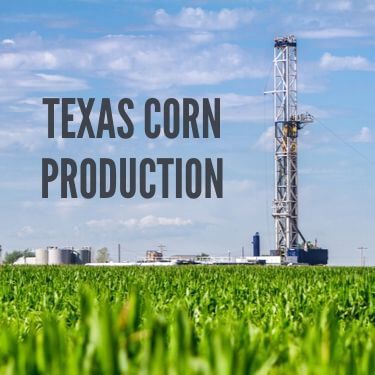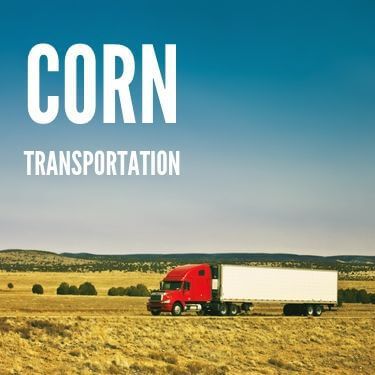You have to be able to answer the question “how is corn packaged and shipped” if you’re part of the corn industry. This is especially true for the corn industry in Texas. The adage everything is bigger in Texas applies even to corn. In 2017, more than 300 million bushels of corn were produced in Texas alone. The demand for corn production continues to increase, causing a growing investment in how corn is packaged and shipped.
The United States Department of Agriculture (USDA), is anticipating a rise in corn exports within the next decade. Answering the question, “how is corn packaged and shipped,” also means finding solutions to common problems within the corn industry. In addition, Texas manufactures must understand Texas corn production, Texas corn supply chain and proper corn transportation in order for their goods to go from the farm to the market.

The United States produces more corn than any other country and Texas contributes immensely to that economy. In 2018, Texas ranked in the top ten for states that planted and harvested the most corn.
Temperature is the primary reason Texas is the ideal location to grow corn. Farmers have 120 days on average from the initial planting to harvesting. It’s crucial to monitor the temperature prior to patching seeds into the soil.
Different groups of corn take various time periods to reach full maturity. Sweet corn, for example, takes 60 to 100 days to mature. Due to the differing growth phases, the cycle of planting the seed to eating it off a plate can take almost an entire year.
Agriculturists typically begin planting in early January all the way through June, but it’s advised that farmers wait until the end of January as corn can freeze. Harvesting months start as early as July and end in late November.
Texan farmers:
Learn more with our Shipping Guide for Corn Season in Texas.
If you are inclined to the corn industry, you will notice the numbers associated with corn production fluctuate consistently. Unpredictable weather in the different Texas regions places a strain on the production and harvesting of this vegetable. Rainfall coupled with temperature is sporadic making production problematic, but unfortunately, these are not the only concerns. Pests, diseases and weeds are among other disadvantages.
Corn is vulnerable to insect attacks throughout the season. Despite the routine crop mites, some insects could compromise the entire batch if proper measures are not taken. Pests are the most abundant around sweet corn, and seed production corn.

Some of these pests include:
Insecticides are the most prominent solution for vanishing insects and bugs from crops. Farmers should use caution when spraying their crops with chemicals, pests are becoming immune to some of the most popular treatments due to overuse.
Frequent crop inspections can minimize the amount of pesticides necessary. However, farmers should still caution against overusing pesticides that can cause the crop to be damaged in the long term.
There are more than ten diseases that can raid corn crops. Some of the most common are:
Just as insects can become immune to insecticides, vegetables can grow a tolerance to some diseases. Farmers can prevent the possibility of their crops being infected by planting disease-resistant hybrids and maintaining crop rotations.
Of all the challenges corn production incurs, weeds are the number one concern for most farmers. More than 80 percent of pesticides are used to abolish weeds. The majority of cultivators depend on Atrazine meanwhile, this herbicide is under review by the Environmental Protection Agency (EPA).
Other common herbicides include:
Although most corn is found on the canned aisles of the supermarket, cold-chain logistics plays a significant role in corn production. Predominantly all harvested corn is utilized to feed livestock, surpassing the ten percent intended for food purposes. The remainder goes into our gas tanks as ethanol. Depending on the purpose of the corn, the supply chain procedure may be slightly different.
Sweet corn should be refrigerated immediately after retrieval or the sugars could quickly turn to starch. Due to the short two-week life span, it is crucial to keep this breed cold even during transit. Local and direct transit or warehousing has to be completed quickly and efficiently to maintain quality. Recommended storage is 32 degrees Fahrenheit with a 98 percent humidity rate.
However, if corn has gone through the dry milling process to feed livestock or for ethanol, it can be stored at room temperature and hauled without refrigeration. In fact, it is good for up to 12 months. If transporting dry corn on a truck, the water content of the corn should not exceed 14 percent. At this point, corn begins to mold and it will produce a sour odor.
Packaging corn is the most simple part of the supply chain process. It is packaged one of two ways, in bags or bulk. Bags can be stacked on a pallet when they are shipped for easy transportation and storing. Bulk totes are used for fresh corn, this method usually requires openings for corn to breathe because the corn can heat internally after sitting for too long.
Sweet corn is packaged differently because this perishable item is packed with ice and water before it’s shipped.
Wirebound crates and fiberboard boxes are the two most popular ways to load sweet corn. Wirebound crates are shipped in rows to allow space for breathing and room for ice. Fiberboard boxes are moisture-resistant, these can be stacked high and topped with ice, as the ice melts it flows between the boxes to cool the entire truckload of corn.
Texas isn't the only place corn grows. Learn how to ship Georgia sweet corn with an expert freight partner.
For the past 20 years, the demand for corn has continuously increased. As exports for the U.S. has risen, the acres allotted to farmers has not shifted much. Transportation is the interlink of farms to tables.
The pressure on transportation services spike when production and consumption escalates. A change in agricultural production can result in a shortage or surplus of shipping services.
Short-term problems consist of:

The cost of transportation at the time of shipment can affect what mode the goods will be transported. Trucks are the most common way to transport corn domestically. In 2011, trucks moved about 80 percent of corn within the country.
While trucks dominate in moving corn domestically, 54 percent of corn was exported internationally using ocean shipments in 2011. According to the USDA’s ten-year plan, rail and ocean transit will become responsible for moving products to ports on the West Coast, Gulf of Mexico, Atlantic Ocean, and the Great Lakes.
In the last decade, the orders for corn increased domestically for ethanol purposes. However, the United States Department of Agriculture (USDA) projects the demand for exported corn will exceed domestic necessities. Whether you are a farmer or a manufacturer, a reliable carrier will be key to moving your freight quickly following trends in demand.
Shipping sunflower seeds requires similar care and attention. Learn more.
With the extreme demand for corn and the expected increase, your business will need to partner with an experienced and dependable logistics team to handle your freight and help you answer the question, “how is corn packaged and shipped.” There are a multitude of challenges facing the corn industry: weeds, diseases, how to package and ship corn, even those little pests. Planting and harvesting corn is difficult enough, let R+L Global Logistics take care of the obstacles associated with shipping and transportation. We are prepared to be your partner for shipping freight from Texas, regardless of whether that freight is corn or another commodity.
R+L Global Logistics has more than 20 years of experience and we understand the problems and solutions within the logistics and transportation industry. Our multilingual staff will provide top-tier customer service ensuring your product makes it to market shelves. From multiple truckload shipping options to warehousing, we will cover the entire process for you. Call today at 866-353-7178 to receive a free quote!
R+L Global Logistics
315 NE 14th St., Ocala, FL 34470